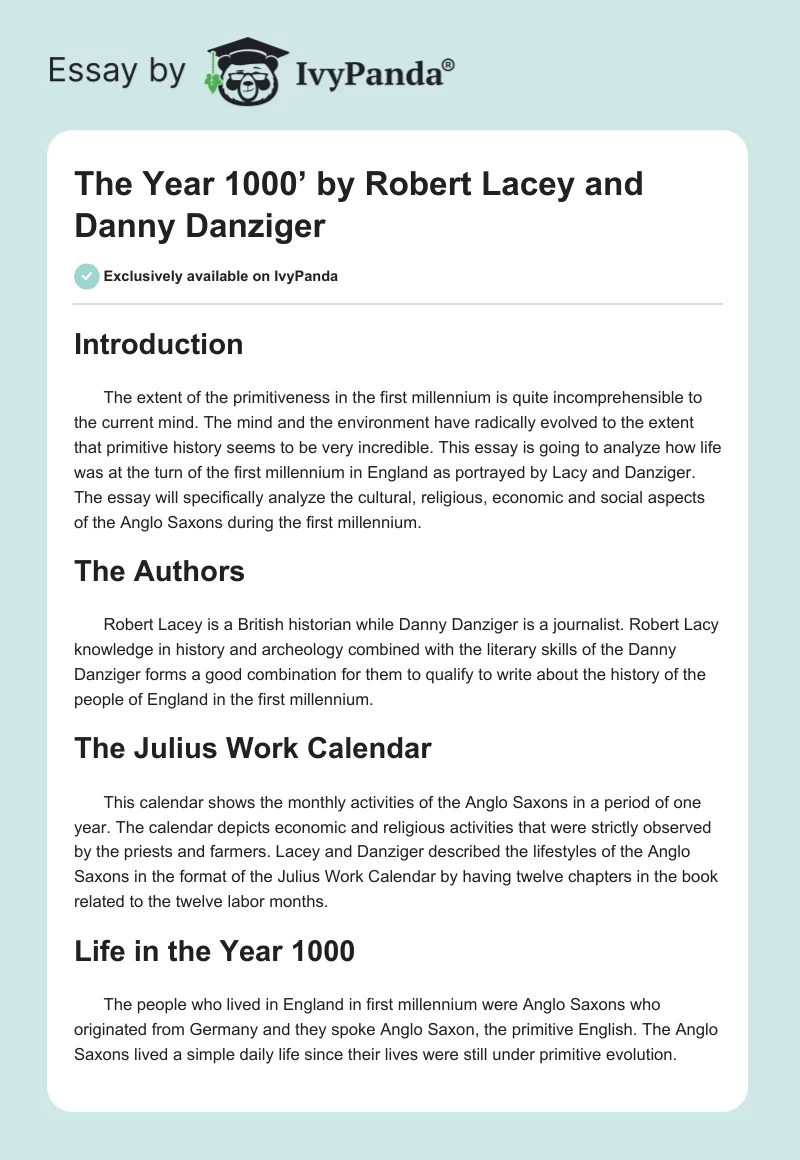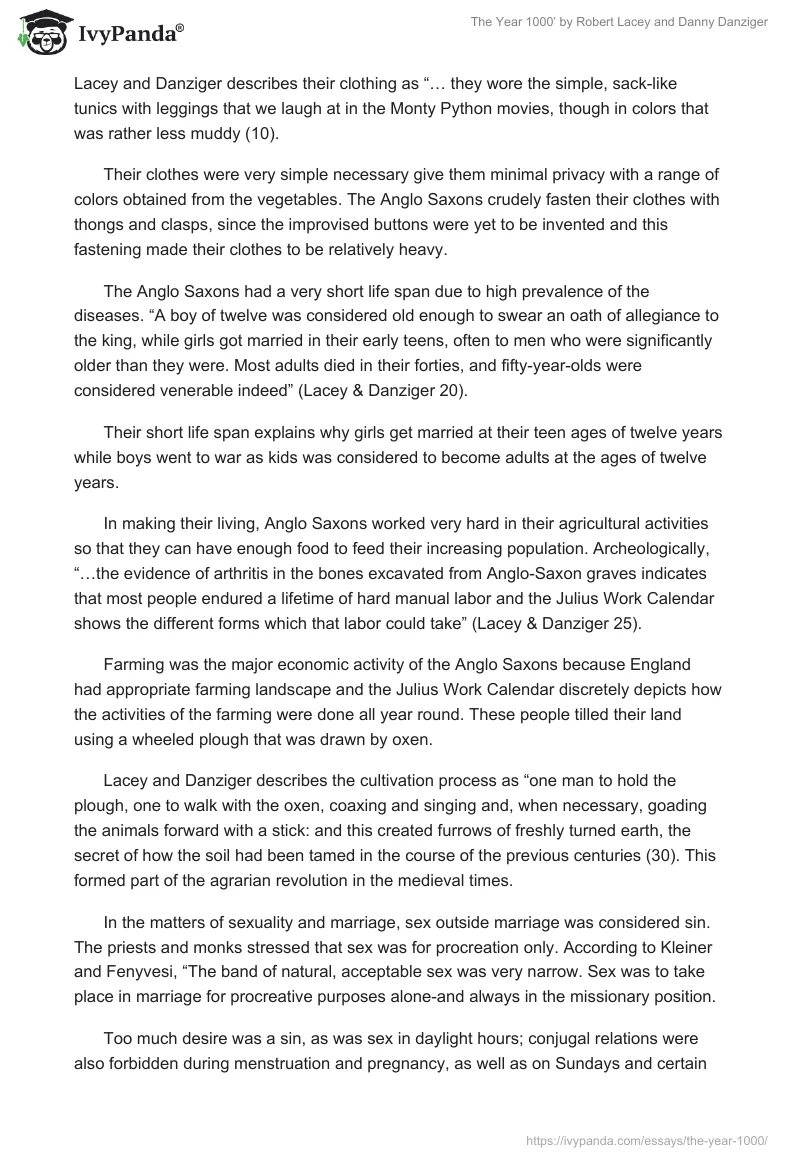Introduction
The extent of the primitiveness in the first millennium is quite incomprehensible to the current mind. The mind and the environment have radically evolved to the extent that primitive history seems to be very incredible. This essay is going to analyze how life was at the turn of the first millennium in England as portrayed by Lacy and Danziger. The essay will specifically analyze the cultural, religious, economic and social aspects of the Anglo Saxons during the first millennium.
The Authors
Robert Lacey is a British historian while Danny Danziger is a journalist. Robert Lacy knowledge in history and archeology combined with the literary skills of the Danny Danziger forms a good combination for them to qualify to write about the history of the people of England in the first millennium.
The Julius Work Calendar
This calendar shows the monthly activities of the Anglo Saxons in a period of one year. The calendar depicts economic and religious activities that were strictly observed by the priests and farmers. Lacey and Danziger described the lifestyles of the Anglo Saxons in the format of the Julius Work Calendar by having twelve chapters in the book related to the twelve labor months.
Life in the Year 1000
The people who lived in England in first millennium were Anglo Saxons who originated from Germany and they spoke Anglo Saxon, the primitive English. The Anglo Saxons lived a simple daily life since their lives were still under primitive evolution. Lacey and Danziger describes their clothing as “… they wore the simple, sack-like tunics with leggings that we laugh at in the Monty Python movies, though in colors that was rather less muddy (10).
Their clothes were very simple necessary give them minimal privacy with a range of colors obtained from the vegetables. The Anglo Saxons crudely fasten their clothes with thongs and clasps, since the improvised buttons were yet to be invented and this fastening made their clothes to be relatively heavy.
The Anglo Saxons had a very short life span due to high prevalence of the diseases. “A boy of twelve was considered old enough to swear an oath of allegiance to the king, while girls got married in their early teens, often to men who were significantly older than they were. Most adults died in their forties, and fifty-year-olds were considered venerable indeed” (Lacey & Danziger 20).
Their short life span explains why girls get married at their teen ages of twelve years while boys went to war as kids was considered to become adults at the ages of twelve years.
In making their living, Anglo Saxons worked very hard in their agricultural activities so that they can have enough food to feed their increasing population. Archeologically, “…the evidence of arthritis in the bones excavated from Anglo-Saxon graves indicates that most people endured a lifetime of hard manual labor and the Julius Work Calendar shows the different forms which that labor could take” (Lacey & Danziger 25).
Farming was the major economic activity of the Anglo Saxons because England had appropriate farming landscape and the Julius Work Calendar discretely depicts how the activities of the farming were done all year round. These people tilled their land using a wheeled plough that was drawn by oxen.
Lacey and Danziger describes the cultivation process as “one man to hold the plough, one to walk with the oxen, coaxing and singing and, when necessary, goading the animals forward with a stick: and this created furrows of freshly turned earth, the secret of how the soil had been tamed in the course of the previous centuries (30). This formed part of the agrarian revolution in the medieval times.
In the matters of sexuality and marriage, sex outside marriage was considered sin. The priests and monks stressed that sex was for procreation only. According to Kleiner and Fenyvesi, “The band of natural, acceptable sex was very narrow. Sex was to take place in marriage for procreative purposes alone-and always in the missionary position.
Too much desire was a sin, as was sex in daylight hours; conjugal relations were also forbidden during menstruation and pregnancy, as well as on Sundays and certain holidays” (5). The sexual lifestyles of Christians were very limited and restricted to the stipulations of the priests and monks.
Christians and paganism differed in their perception of sex; hence, women had different roles to play in the matters of sexuality and marriage. For instance, “a woman whose mate was inattentive could take matters into her own hands and whip up a batch of love potion.
The sex-starved lass would undress, cover her body with honey, and roll around in a pile of wheat; then she would pick off the grains and grind them into flour used for a bread dough, to be kneaded between her thighs and then baked” (Lacey & Danziger 126). The practice shows how women play their role of in sexuality in the making of the medieval aphrodisiac that was used to enhance the sexual ability of the men.
The religion of the Anglo Saxons had the elements of Christian and pagan origin. They greatly revere the portraits and figures of the saints.
They draw and relate to the experiences of the saints such as “Simeon Stylites, the fifth-century hermit who spent much of his life living naked on top of increasingly high pillars, or learning from the life of Mary of Egypt, the patron saint of fallen women” (Lacey & Danziger 150).
Every morning, people go to their respective monasteries and offer supplication of according the saints’ figures that are assigned each day and they believed that they could attend to their worries and troubles. The monks spend their lives in the monasteries preaching according to the Julius Work Calendar by reciting the monthly festivals of the saints.
The eating habits of the Anglo Saxons were still primitive as “a dinner guest was expected to bring own carving knife” (Kleiner and Fenyvesi 8) to the festival where the main meals were mutton, beef, poultry and pork supplemented with the greens and honey.
They also fed on snails to improve their health status. The kinds of the diets that they took reflect their health status that lead to the rapid population growth during the medieval times.
Conclusion
The human existence today is based on the primitive evolution of the lifestyles from time immemorial. The lifestyles of the Anglo Saxons in the first millennium as depicted by Lacey and Danziger were too primitive as compared to the present British people and even the world population.
Humanity has endured the harsh conditions of life but has evolved with time with the objective of attaining the perfection in terms of the quality of life and living. The wisdom, knowledge and skills we have today will enable us face future challenges as the Anglo Saxons did during the first millennium.
Works Cited
Kleiner, Carolyn & Fenyvesi, Charles. “Life & Culture” U.S. News & World Report, 1999. Web.
Lacey, Robert & Danziger, Danny. “The Year 1000: What Life Was Like at the Turn of the First Millennium: An Englishman’s World.” 2000. Web.


